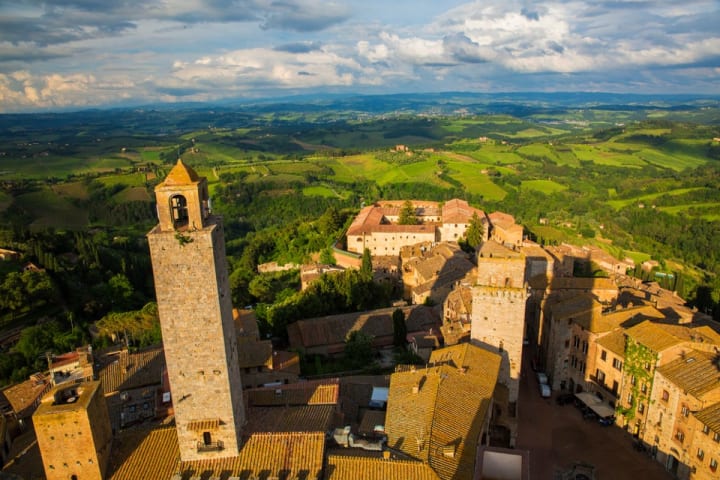The Devil We Invent: The "Monster of Florence" Was Merely a Man
Getting meta about true crime and why we're unwilling to accept evil is banal and commonplace

Glutting ourselves on misery
The problem with the true crime genre is that it's rife with manufactured mystery so that its merchants of misery can wring a few bucks out of a tragedy. When we rake through witness statements and freeze-frame interviews, we aren't treating the loss of life with respect. Instead, we are reducing murder to an intellectual puzzle at best and tasteless entertainment at worst. We merchants and consumers of misery ought to be ashamed.
The thing about violent crime is that it's all so sad and predictable it fails to be scintillating on its own. That's why misdirection and clever storytelling techniques are required to plant doubt in the viewers (I should say, voyeurs) until they're in a tailspin, wondering whether murdered wives have been fatally gouged by owls and missing husbands fed to tigers.
A few years ago, we were swept up in the cultural phenomenon that was the Serial podcast. It was fun; the hosts alternately dramatic and wisecracking. It was entertaining to swap conjecture and float new theories to our friends ("Oh, is that what you think, wait until you get to Episode 3!"). We were desperate to plumb depths that did not exist and ravenous for a plot twist that never came.
Spoiler: the ex-boyfriend did it after all. What irks me is I can still remember his name after all this time, but while listening to the podcast, I would periodically forget the victim's. Strange how the person at the heart of a true crime story is both catalyst and afterthought, about as fleshed out as a chalk outline. (What can I say? We prefer an active protagonist.)
A woman is found dead at the bottom of The Staircase, spawning a popular Netflix documentary. Was it merely an unfortunate slip down the stairs, as her husband claims? The prosecution argues her husband bludgeoned her to death after discovering his bisexual affairs, then threw her down the stairs to fake an accident. The defence asserts it was a fatal drunken fall. Hang on? Just like the one that killed his female friend, whose daughters —who strikingly resemble him— he adopted? Coincidence, inspiration, or is "Blame it on the staircase" this guy's modus operandi? The prosecution's theory lacks allure because it's too straightforward. Too simple for us; we prefer grand coincidences, twists and turns to keep us on our toes and glued to the screen.

Websleuths would prefer to think an owl flew in at that exact moment, lacerating the victim's head and causing her to lose her balance before flying away into the warm summer night. But, unfortunately, the majority of murdered women are killed by their current or former male partner. What a depressing fact, and perhaps one of the reasons viewers were hoping for an alternative explanation— the staircase did it, an aggressive nesting owl did it. Comedienne Michelle Wolf skewers true crime documentaries of this sort mercilessly in her bluntly titled parodyThe Husband Did It.
For me, true crime has worn out its welcome, and yet, I'm only human and find myself sucked in from time to time. The mind whirrs away into the wee hours of the morning. Obsessively, unhealthily, I pore over statement and body language analysis videos. I am rewarded by spotting duping delight (a momentary quirking of the lip when the guilty party cannot suppress their joy for having all of us fooled) or catching a Freudian slip in a decades-old interview. Oh, the witless public believed their PR campaign, but I know better. I am better. And so, while I can feel smug about knowing the truth behind the truth, what good does it do anyone?
In forums, misquotations morph into popular theories, which branch off into many more right before my very eyes. Two police artist sketches of the same suspect split him into a fictitious duo, doubling the intrigue. Ah, the frayed, messy, and heavily embellished rich tapestry of it all. Of course, one must resist becoming entangled in all its loose ends. But most of all, one must get on with one's life rather than seethe in self-righteous indignation because "They got away with it". (And? What are you going to do about it?) Unless you're solving a cold case and giving closure to grieving relatives, you're merely indulging your morbid curiosity, and there's nothing admirable about that. Call a spade a spade (and "the murder weapon" if necessary).
Of Monsters and Men
I confess, when I was a first-year psychology student, I found myself fascinated by psychopaths. To think, people wholly unburdened by a conscience walk among us, sometimes thriving as CEOs, lawyers, and surgeons, often sitting behind bars for crimes most heinous. Psychopaths aren't mysterious; they're just under-developed in the areas of the brain which comprise our empathy "circuit". I'm not talking about an intellectual understanding of empathy or the ability to cleave to societal conventions where advantageous. I mean the visceral kind of empathy. It produces the sort of pain that cuts you to the quick, which you cannot help but feel right down to your bone marrow when someone else is hurting.
I did not like what I learnt while researching psychopaths; it's true what they caution about gazing into the abyss. Because here's the real scary part: empathy has an off-switch. Given the right circumstances, we can all be as callous as a psychopath. And we don't even have to dehumanise the victim; we merely have to convince ourselves that they deserved it. Typically, when we imagine another person's pain, it makes us think of our own, activating the anterior cingulate cortex and enabling us to empathise. However, brain scans show that when we feel a victim deserved their fate, the anterior cingulate cortex fails to light up, with this effect is particularly pronounced in men.
As long as we believe a punitive action is justified, we feel nothing for its recipient. And one can justify anything; it all boils down to semantics, framing, in-group versus out-group and, not forgetting, our penchant for self-serving mental gymnastics. Whether you're gleeful a child murderer will fry on the electric chair or scornful of a drunk "party girl" raped while unconscious and dressed in immodest clothes, this is the mechanism at work. From victim-blaming to mass murder in the millions, every atrocity is neither inexplicable nor, unfortunately, inhuman. There's also a theory that psychopaths have their empathy switch in the "off" position by default.
That's why I'm not a fan of bombastic titles the likes of "The Monster of Florence" (Il Mostro di Firenze in the original Italian); we elevate evil as though it were extraordinary, not of this world, rather than acknowledging its true nature, its banality and abundance. Willful blindness will not help us conquer it. Come to think of it, "The Banal and Violent and Impotent Man of Florence" is a much better appellation for the appalling, with the added benefit of being unappealing to any would-be copycat killers courting infamy.
This particular pathetic man murdered amorous young couples parked for privacy in the Tuscan countryside because he felt inadequate and envious. And most importantly, he entitled to inflict his pain on others, rather than feeling their pain as his own and staying his hand, showing mercy. The challenge prompt tells me to tell you when it happened: the 1980s and every decade before and since. That's the point: no case is remarkable for its gory details but for the fact that each is singularly and intensely tragic for its loss of life and suffering. The set-dressing or backdrop doesn't matter —though what a lovely one it was:

The Monster of Florence by Douglas Preston is my favourite true crime book, but not for the banal and violent man at its centre. On the contrary, I prefer its periphery, populated by power-mad and superstitious prosecutors, corrupt police, and a bloodthirsty public. The book investigates the "monster's" true identity, for there were many patsies, and in doing so, opens an aperture onto our own unsavoury nature. The serial killer, responsible for at least fourteen violent deaths, was most likely a blue-collar Sicilian gutting his victims with a scuba knife. (He brings up possession of the murder weapon casually, by the by, you know, and I know but prove it in a court of law to the author and his investigative journalist friend. What a braggart. What a lowlife.)
The Italian public found him lacking, disappointing somehow. They much preferred the legend, a monster of their own making: an upper-class doctor elegantly wielding a scalpel to please his shadowy masters with Satanic rituals. Police even found an "arcane relic" at the crime scene, "An esoteric object used to communicate between this world and the infernal regions". It turned out to be the victim's doorstop, pictured below. (Well, I suppose it does look a bit like a 3rd Gen Amazon Echo.)

The "Monster of Florence" case gave birth to the iconic cannibal-killer Hannibal Lecter, a more palatable monster —pardon the pun — yet one as much the polar opposite of his inspiration as it's possible to be. I suppose we want our villains a tad more glamourous than reality affords, with aristocratic airs and complex philosophies to account for their brutality. As though that would render them any less beyond our contempt (but it would make for a more enthralling story). That's the trouble; we revel in true crime tragedies as though they were a fictional tale spun for our enjoyment.
Dietrologia and the Devil
Dietrologia: the obsessive search for supposedly hidden motives behind events or behind people's actions and words.
In The Monster of Florence, Douglas Preston implicates "dietrologia", sometimes translated into English as "behindology", to explain the public's craving for a juicier story. Dietrologia refers to the tendency to reject official explanations in favour of the convoluted and consequently satisfying. We seek the truth behind the truth so that we may be smug about it. No one wants to be the rube who accepts things at face value, only to find out later down the line something far murkier lay beneath the surface all along. By this reckoning, it's better to be a cynic than to be wrong. (Whereas every dyed-in-the-wool cynic laments they're not wrong more often.)
In short, not only are we vultures picking over true crime stories, merchants and consumers of misery, but we are much too enamoured with monsters and the Satanic. We want brutes to be "monsters" so that we may disqualify them from humanity and preserve our collective image. We feel the need to externalise evil as an otherworldly tempter possessing supernatural powers of influence and agency to downplay our own. According to Voltaire, "If God did not exist, it would be necessary to invent him". Well, it looks like we invented the Devil too.
About the Creator
Angela Volkov
Humour, pop psych, poetry, short stories, and pontificating on everything and anything






Comments
There are no comments for this story
Be the first to respond and start the conversation.